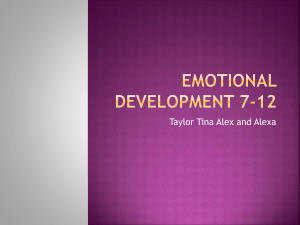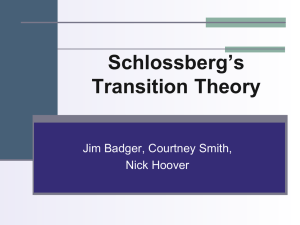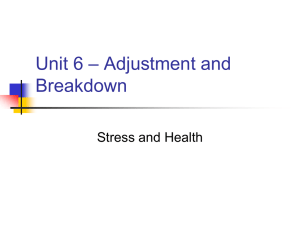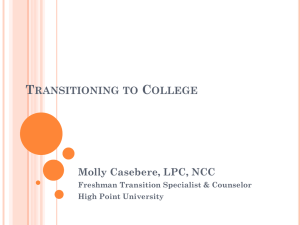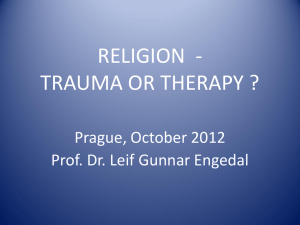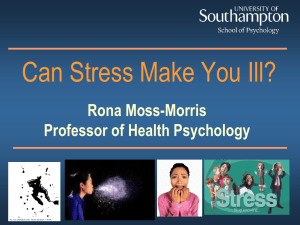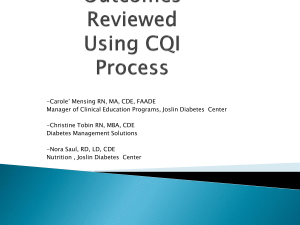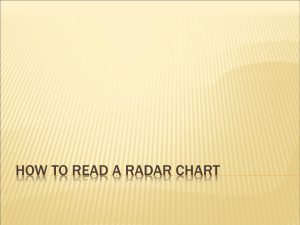Student teacher stress and physical exercise
advertisement
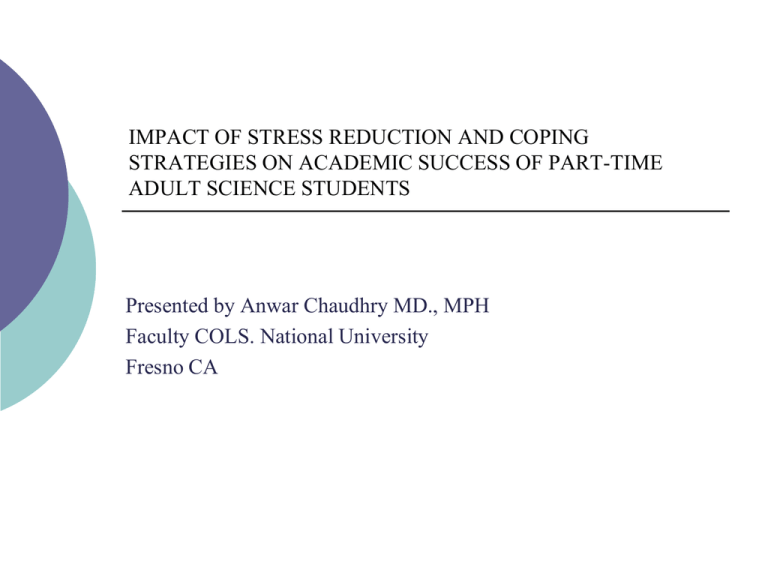
IMPACT OF STRESS REDUCTION AND COPING STRATEGIES ON ACADEMIC SUCCESS OF PART-TIME ADULT SCIENCE STUDENTS Presented by Anwar Chaudhry MD., MPH Faculty COLS. National University Fresno CA Presentation Outline Introduction Research Questions Literature Conceptual Model Methods Results Discussion Conclusion: Implication, Limitations and future directions Abstract •Background: This research article examined the triggers of academic stress, its impact on the emotional, psychological and physical health of part-time adult science students. It further evaluated the effectiveness of a stress reduction program on the wellbeing and learning abilities of the students. •Methods: A prospective, interventional, single-arm cohort study design was used on a convenience sample of 16 students (n=16) at a National University. Based on a framework of social cognitive theory, a 6-week cognitive behavioral intervention program of group activities was designed and implemented to empower students to identify and cope with the triggers of stress. Primary data were analyzed using parametric two-sample dependent ttests and the non-parametric Wilcoxon Rank Sum Test at an alpha of 05. The 10-item Cohen Perceived Stress Scale and a questionnaire designed for the study were utilized to determine participants’ perceived levels of stress before and after intervention. •Results: Major factors interfering with the learning process in part-time adult science student population were found to be personal, family, job responsibilities and situations. PSS score, pulse and blood pressure difference was calculated by comparing baseline and week 6 score using paired sample t-test. The intervention group showed significant reduction in stress. Impact of counseling was assessed using the pre-test post-test analysis. Fourteen of the 16 participants (87.5%) stated that attending personal counseling had a positive impact on their academic performance. •Conclusion: A six weeks follow-up showed that the stress reduction and coping strategic interventions had positive effects on perceived stress among the students, and further analysis showed that this was due to participation in self-development groups. Stress The tension that emanates from an individual’s interaction with the environment. o In this interaction, the individual perceives that the demands of the environment exceeds his or her personal resources(Lazarus & Folkman , 1984). Although stress is not a mental disorder, stress has been reported as a contributing factor or comorbidity of mental illnesses. Stress Background and Statistics o o o According to (CDC) estimation 1 in 2 Americans are annually diagnosed with a mental disorder ( Center for Disease Control and Prevention , 2005) National Center for Health Statistics attributed 46 million physician office-based visits in 2003 to mental disorders. (National Center for Health Statistics, 2005) In a study conducted by the American College Health Association , 63% of college students felt “hopelessness” at times, and 94% reported feeling of “overwhelmed”. Forty-eight percent of females and 39% of males reported that they felt so depressed it was difficult to function ( American College of Health Association. Mental and physical Health data,2002). Introduction o o o This study examined the perceived stress among part-time adult science students which tends to affect not only academic performance but also physical, emotional, and social health of students. It further investigated the relationship of vital signs (blood pressure and pulse) changes before and after intervention therapies. Adult students in non-traditional institutions seeking professional science education in fast paced format are vulnerable to tremendous amount of stress. (World Health organization, 2000; Saipanis, 2003). Major triggers of stress are found to be inability to cope, helplessness, increased psychological pressure, mental tension, financial and excessive workload (Galbraith & Brown, 2011). Introduction (Cont’d) Part-time adult students report high level of stress due to lack of leisure time and minimal opportunity to relax, leading to serious physical emotional and psychological consequences (Dixon &Kurpius, 2008). Other important factors interfering the learning process in this student population are; family and job responsibilities and situations (e.g., financial worries, childcare, domestic violence and transportation issues) (Coffield, Moseley, Hall, &Ecclestone, 2004). The effects of these stressors can produce many emotional conditions that include: alcohol and drug abuse, relationship difficulties, depression, anxiety, and suicide (Levey, 2001). Introduction (Cont’d) o Group activities are planned and intended to ameliorate one’s physical and psychological conditions ( Buckworth & Dishman, 2002) o Research studies results have revealed that social networking is one of the factors strongly associated with high stress tolerance ( Ainslie RC; Shafer A; Luther SS et al,. 2006). Purpose of the study o o The objective of this study was two- folds: (a) Increased knowledge to identify signs and symptoms of negative stress (b) To design self –support interventions (opportunity for emotional expression, peer affiliations, self- support groups) to cope stress. The investigator’s goal was to develop a program to control stress by education and behavioral modifications to promote health by stress reduction and improve learning abilities and success in educational pursuits of adult part-time science students Conceptual Model Bandura’s Social Cognitive Theory The Bandura’s (SCT) theory accounts for following key points for the influence one’s environment has on the behavioral choices he or she makes. The individual must view the results of the change as positive. Students will see the participation by peers in the stress release activities as being fun and effective for them which is a positive result. Different group activities give students the opportunity to see others having fun and relieve stress at the same time. The positive feedback the students give each other while engaging in these activities serve as a response for the behavior to continue. Self-expectation of student’s cognitive success and performance, depends upon past achievements, self-efficacy and overall level of self- control. Self- efficacy produces confidence in the students to perceive stress as a challenge and enhances the sense of well -being, performance and persistence resulting in to academic successes (Bandura 1982). Students perusing higher education are provided healthy learning environments, enhanced self-efficacy, and knowledge about stress management techniques to produce positive behavior change based on the cultural, ethnic, educational, and economic backgrounds. Coping Strategies: Group Activities - - Peer Affiliations is a group of activities that are planned and intended to ameliorate one’s psychological, physical and emotional condition (Buckworth & Dishman, 2002) peer tutoring Emotional ventilation physical activities self-regulated learning effective time management skills Literature : Peer Affiliations and Stress o o o o Loehr (1997) proposed that: Group activities are associated with lower level of stress Group activities may change the perception of events Group activities are connected with improved coping Literature : Stress Triggers Non-program Gender Lack of background knowledge Emotional intelligence o Program Workload Student behavior and learning Challenges and distractors faced by adult learners to maintain a balance between school/work/family o Research Questions o o o o o o An effort was made to answer the following question. “Can enhanced knowledge of the effects of stress and greater use of positive coping skills reduce the stress and improve academic performance”. 1-What is the perceived level of stress experienced by students during biology course? 2- What are the major causes of stress? 3-Is excessive stress leading to poor student performance? 4-Can a reduction of stress improves their performance? 5-Can a stress release program make students better aware of the signs and symptoms of stress within their own lives? Method : Sample o o o o o o o o A convenience sample of 16 students enrolled in biology course at National University Fresno campus. Inclusion criteria was based on Perceived Stress Score of >14 12 females and 4 male participants in the age range of 16 to 35 years of age. Results from all 16 participants scores were analyzed. Diverse previous educational experience. Non-traditional adult learners Insufficient knowledge about the subject Time constraints, family, and financial issues Research Instrument Perceived Stress Scale (PSS) The Cohen Perceived Stress Scale 10 Item (PSS-10) was utilized to determine each participant’s perceived level of stress The measurement is scored as a Likert scale and consists of 10 items that are measured on a five-point scale The higher the score is, the higher the perceived level of stress of the student 0=never , 1=almost never, 2=sometimes, 3=fairly often, 4=very often Various stress relief sessions used in the study Type of Data Collected Qualitative data Gender of the subjects Sources of stressor Coping strategies adopted during events of stress Impact of counseling on training program Effect of counseling in reducing stress Retention and personal counseling Type of Data Collected Quantitative data a. Change in PSS before and after the intervention b. Pulse c. Systolic blood pressure d. Diastolic blood pressure Data Collection Data collection done in three phases: 1. 2. 3. Baseline Follow-up Post follow-up Statistical Plan Both quantitative and qualitative data (pre and post test design) collected in three phases, were analyzed using parametric twosample dependent t-tests and the non-parametric Wilcoxon Rank Sum test at an alpha of 0.05 (95% confidence interval). The 10-item Cohen Perceived Stress Scale and a questionnaire designed for the study were utilized to determine participants’ perceived levels of stress before and after intervention. Results Research question # 1 and 2 Sources of Stressors Overall, most participants felt that their stressors impacted their focus and understanding of the training program Most frequent sources of stress were: a. Lack of science background b. Financial constrain c. Worrying about the future d. Vastness of curriculum/syllabus Other stress causing factors include: family related problems, staying away from family members. Research question # 3 Coping strategies adopted by the students during events of stress Five most common coping strategies; a. Positive reframing b. Planning c. Acceptance d. Active coping e. Self distraction Other strategies also includes religion and alcohol/drug use Research question # 4 and 5 Impact of counseling on training program 14 (87.5%) out of 16 participants stated that attending personal counseling had a positive impact on their academic performance Effects of Counseling on Stress Fourteen (87.5%) out of sixteen participants stated that they agreed that utilizing personal counseling reduced stress This complements the results of the PSS-10 questionnaire that was used in the quantitative component of this study Limitations In terms of the qualitative component, one limitation is that the interpretation of the question and expressing their views varied person to person but all the participants expressed in a positive way towards impact of counseling on overall and academic stress Diversity in age Gender Educational background Limitations (cont’d) Sample size Gender Age Family Self-selection The primary limitation of this data is the small sample size There were only four male subjects in the study, this may be a limitation because coping strategies and other characteristics differs between the different sexes This research will assume the variable of stress related specifically to final exams and papers as a confounder. Discussion : Research questions Changes in PSS before and after the intervention 13 subjects (81.2%) found to have PSS score more than 20, which showed a significant stress had been felt by students Mean pre-test score was found to be 23.25+4.12 Mean post-test score was found to be 18.89+3.03 Pulse A significant difference between pre-post-test pulse was observed for week 2 (P = 0.007), week 3 (P = 0.001) However , baseline pre-test and week 6 post test pulse (P = 0.09) was not statistically significant. Discussion : Research questions Changes in PSS before and after the intervention There is a significant decrease in the PSS score after the 6 weeks of the intervention (p<0.001) Change in pulse after every follow-up Systolic blood pressure Mean SBP score at baseline was 127.75+15.38 and at the end of the study i.e., 6th week it was 124.50+11.24 Change in Systolic Blood Pressure after every follow-up Systolic blood pressure (mmHg) Change in Systolic Blood Pressure after every follow-up 135 130 * * * * 125 * 120 115 110 105 100 Week 1 Week 2 Week 3 Week 4 Time Pre-test scores Week 5 Week 6 Baseline (pre-test) vs Week 6 (post-test) Diastolic Blood pressure A significant difference between pre-post-test DBP was observed for week 2 (p = 0.017), week 4 (p = 0.027), week 5 (p = 0.001) and week 6 (p = 0.035) A significant reduction in the baseline pre-test and week 6 post test DBP (p = 0.001) was observed. Diastolic blood pressure (mmHg) Change in Diastolic blood pressure after every follow-up 80 78 * 76 74 * * * 72 70 68 66 64 Time Pre-test scores Post-test * Summary of Findings Present study identified most prevalent stressors, coping strategies and impact of stress reducing program on over all stress, wellbeing and academic performance. Baseline interview revealed that ‘lack of science background’ (knowledge about anatomy and physiology), ‘financial constrain’, ‘worrying about the future', and 'vastness of curriculum/syllabus' are the most frequently occurring sources of stress Summary of Findings (cont’d) Overall, most participants felt that their stressors impacted their focus and understanding of the training program Common coping strategies adopted were 'positive reframing', 'planning', 'acceptance', 'active coping' and 'self distraction'. Other strategies also includes religion and alcohol/drug use. Summary of Findings (cont’d) Fourteen (87.5%) out of sixteen participants stated that attending personal counseling had a positive impact on their academic performance. All the sixteen participants explained their plans to continue their education with excitement, and it seemed that they had thought it over prior to being asked . Significance of Findings Present study also identified various coping strategies followed by the students in general which includes self distraction, religion and others Present study showed that structured counseling sessions helped the students in improving the stress condition which was seen quantitatively by a significant decrease in perceived stress score and qualitatively by asking the question. Significance of Findings (cont’d) This study helps in understanding the sources of stress, knowledge of reasons for stress, types of coping strategies used and impact of stress relieving counseling programs, which helps in better achievement of pre-nursing part time students. Future Directions Enrollment of students who completed pre-requisites for the biology course. Structured and strategic academic courses /programs and stress Relationship between triggers of academic stress and coping strategies Relationship between body and mind
